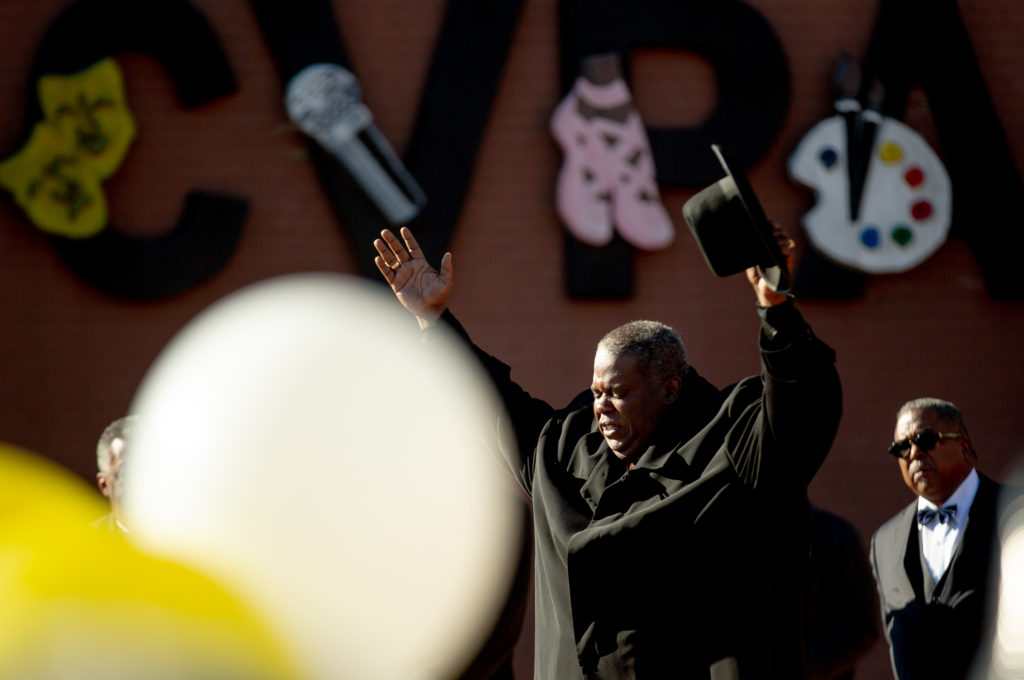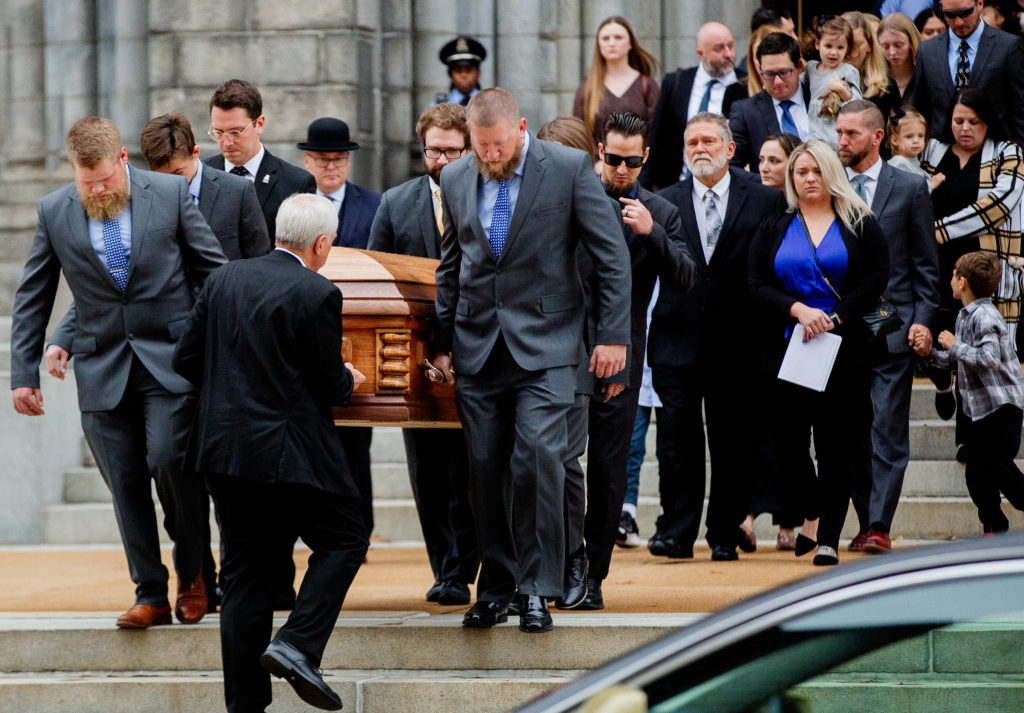Covering a school shooting with compassion
Car headlights streak by as I drive on Route 154 in rural northeast Missouri.
The glow from my car’s clock glows back at me – 4:50 A.M. Gravel under my car crunches as I pull off to a general store near Paris, Missouri.
“Oh I didn’t see you there!” the register worker tells me under the glow of yellow-tinted fluorescent overhead lights. I pour myself a cup of hot coffee and walked around the shop, greeted by live minnows and a sweatshirt that reads “I peed in the lake — Mark Twain Lake, Missouri.”
The start of my day took me to humble farming communities outside of Missouri’s city centers to help answer the question — why have Democrats lost ground in Missouri House of Representatives’s 18th District?
-

Theresa Leachman, 39, right, consoles Jordan Williams, 21, on Wednesday, Oct. 26, 2022, during a vigil outside Central Visual and Performing Arts High School. Williams is a former member of the Dazzling Diamonds Dance Team who danced with 15-year-old Alexzandria Bell — one of the victims in this week’s shooting at the south St. Louis high school. “I’m just devastated,” Williams said. “Alex was always smiling and laughing.” -

Hundreds gather to remember physical education teacher Jean Kuczka and 15-year-old student Alexzandria Bell on Wednesday, Oct. 26, 2022, outside of Central Visual and Performing Arts High School in south St. Louis. The two were killed during a school shooting earlier in the week. -

Bishop Lee Scott, of Lively Stone Church of God, leads a prayer while calling for gun legislation reform on Wednesday, Oct. 26, 2022, after a school shooting that left two dead at Central Visual and Performing Arts High School in south St. Louis. “This gathering is a start of a movement,” he said. “We want people to know we are working to make a better community. As clergy — people of faith — we don’t move without God.” -

Family members follow a casket carrying Jean Kuczka, a 61-year-old health and physical education teacher at Central Visual and Performing Arts High School, on Monday, Oct. 31, 2022, outside the Cathedral Basilica in St. Louis’ Central West End neighborhood. “The world is truly a better place because of Jean,” said Stephen Kuczka Jr., Jean’s son, while flanked by his siblings at the funeral mass. “She touched each and every one of us, and she has left us with memories we will cherish forever.”
One of the things I enjoy the most about my job as a journalist and visual storyteller is I’m always covering something different. Whether the story takes you to Paris, Washington D.C., or your backyard — you have to have an insatiable curiosity with the world.
I was riding in a combine when I got the first text from a colleague: “Are you at home?” Then a flurry of phone calls spattered in when I was able to get a sliver of phone service.
“There’s been a school shooting at Central Visual and Performing Arts,” one coworker told me, reassuring me they had it handled to begin with. I wrapped up my trip as quickly as I could and hit the road back to St. Louis, not knowing the situation that was unfolding at the high school in the southern part of the city.
My stomach felt as if it were in knots the closer I got to my neighborhood, not knowing what I was going to see. Every heart-racing minute was tinged with the questions swirling in my head as I attempted to not break the speed limit: How bad is the situation? What was the police response? How could this happen here?
Just earlier this year, a gunman killed 19 students, 2 teachers and wounded 17 others at Robb Elementary School in Uvalde, Texas. Now, an unknown situation was unfolding blocks from my home.
The unfolding scene was one our society is all-too-familiar with: police tape zigzagging the perimeter of the school; local and federal agents scouring the campus; makeshift memorials and vigils popping up around the school; broadcast trucks lining the street with reporters asking the age-old question I asked myself hours earlier: How could this happen?
You can sit in journalism school classes and talk about theoretical scenarios on how to cover traumatic events, but it never truly prepares you, no matter how seasoned the journalist. The one thing at the top of my mind: empathy.
The concept of compassion is one I think can get lost in some media circles. At the end of the day, we’re all human and our lived experiences are one that takes personal understanding. The community we’re reporting on — my own community — had just experienced one of its darkest days and journalists owe them space, an opportunity for healing and for them to share their story if they wish.
It would be ignorant to not acknowledge the challenges St. Louis has with gun violence. Dr. Mati Hlatshwayo Davis, the city’s public health director, emphasized gun violence as one of the city’s biggest public health issues requiring community, city and legislative collaboration to help solve.
“Alone, we can achieve very little,” Davis said during a press conference following the Oct. 24 shooting. “But together we can effectively impact the kind of unprecedented change that is needed.”
Dr. Davis’ comments resonated in my head throughout the last several weeks of reporting on the situation, reminding me that the ability to share the stories of what people had experienced put humanity, and later resiliency, into what would be the 40th school shooting of the year.
In addition, I wanted to make sure we stuck through and documented the community coming lifting each other up during these difficult moments as they honored the life of a passionate educator and young woman whose smile could light up a room.
My latest visual report was on a community celebration to honor the two victims through what Central Visual and Performing Arts High School knows best — arts and performance.
Dr. Kacy Seals Shahid, principal at the school, said giving her students an opportunity to have a healing outlet was crucial and Veronica Russell, a senior at the school, echoed the sentiment and said the event was a turning of a page.
“We’re not sad. We’re not crying. We’re happy. We’re smiling,” she told hundreds of people, in part, at the high school’s football field one recent Sunday. “We’re smiling for our school today.”
While we don’t know what tomorrow will bring, I can say I’m proud of my colleagues for treating these stories with the utmost respect, compassion, and care.
Brian Munoz is a staff photojournalist and multimedia reporter at St. Louis Public Radio. You can view his work at www.brianmmunoz.com, reach him by email at bmunoz@stlpr.org and follow him on social media at @brianmmunoz.